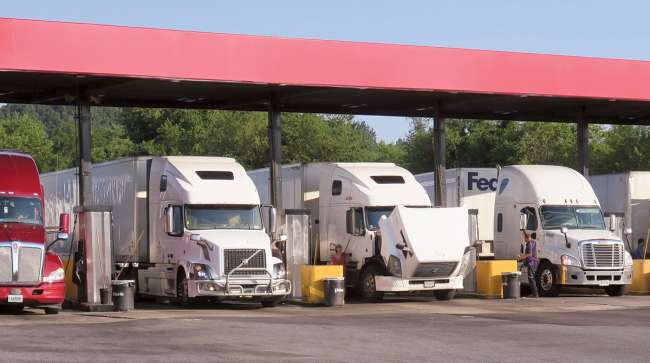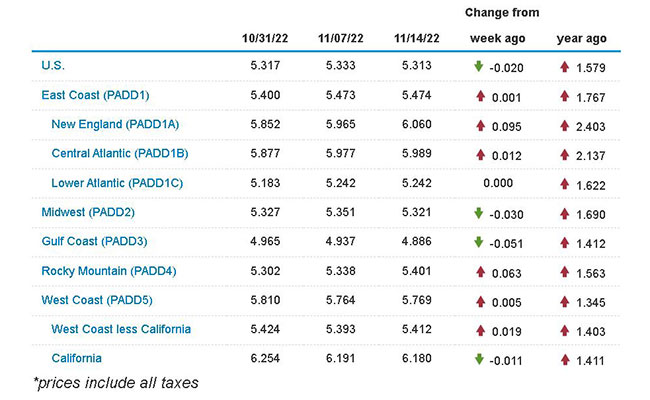Diesel Dips 2¢ to $5.313 a Gallon

[Stay on top of transportation news: Get TTNews in your inbox.]
The national average price of diesel dipped 2 cents to $5.313 a gallon, according to Energy Information Administration data released Nov. 14. A gallon of diesel now costs $1.579 more than it did at this time in 2021.
Of the 10 regions in EIA’s weekly survey, the average price of diesel increased in six, decreased in three and remained unchanged in the Lower Atlantic.
New England showed the biggest gain at 9.5 cents. A gallon of diesel there now costs $6.06 a gallon. On Oct. 3, the price was $4.874. The Gulf Coast had the biggest decline at 5.1 cents.
The national average price for gasoline fell 3.4 cents to $3.762 a gallon, or 36.3 cents more than at this time last year.
U.S. average retail prices for November 14, 2022:
Regular grade #gasoline: $3.76/gal
On-highway #diesel: $5.31/gal#gasprices https://t.co/dsfxiPAGLR — EIA (@EIAgov) November 15, 2022
“Some good news: U.S. gas prices dropping very quickly, and sub-$3/gal numbers now appearing at about 8,000 sites according to OPIS/AAA. Likely to see the lowest gas prices since the Ukraine invasion this month,” Tom Kloza, OPIS global head of energy analysis, posted on Twitter on Nov. 15. As for diesel, the current 2-cent price drop reverses a trend of four increases over the previous five weeks, according to EIA.
“What a ride on diesel, right? The volatility obviously has taken over,” Phil Flynn, senior market analyst for The Price Futures Group, told Transport Topics. “We know supplies are below average. We know people are concerned. Will the refiners try to respond to [strong] prices? Probably, but that doesn’t mean prices are necessarily going to go down.”

Flynn
In a recent blog post, the American Fuel & Petrochemical Manufacturers noted hard conditions aren’t limited to just the public.
“Just like the American people are experiencing inflation, so, too, is the liquid fuel sector. The dollar doesn’t go as far, so expenses have increased at every step of the liquid fuel supply chain,” AFPM wrote. “Labor is more expensive and scarce; crude oil and agricultural commodity inputs are more expensive; powering plants is more expensive; shipping fuel and feedstocks to the markets and facilities that need them is more expensive.”
EIA reported the West Texas Intermediate crude oil futures price on Nov. 14 was $85.87 a barrel. That’s $5.92 lower compared with a week earlier and $5.08 more compared with the 2021 period.
Oil fell as concerns over the near-term consumption outlook overshadowed the risk of tightening supply heading into winter, Bloomberg News reported.
Meanwhile, the demand for diesel is far reaching.

Schaeffer
Trucks, trains, tractors, boats, barges, machines and more rely substantially on diesel, and the U.S. consumed about 34 billion gallons in 2021, Diesel Technology Forum Executive Director Allen Schaeffer noted in a post.
And distillate fuel supplies for those uses “are the lowest since EIA started keeping records in 1951,” he wrote earlier this month, and since the pandemic, U.S. refiners “have been seeking a return to normal cycles of production and maintenance. October had the most refinery maintenance in a while and, therefore, disrupted production more than in previous years.”
The Biden administration has released 180 million barrels of crude oil from the Strategic Petroleum Reserve to fight high fuel prices at the pump.
“But that can only go so far,” according to Bloomberg News. “U.S. refineries are already running flat out, and without excess capacity to process the crude into usable fuel, the extra oil releases don’t do much good.”
U.S. On-Highway Diesel Fuel Prices

EIA.gov
Meanwhile, Heartwell Renewables, a joint 50-50 venture between travel stop operator The Love’s Family of Cos. and agricultural products supplier Cargill, announced construction in November on a production plant that will have the ability to produce about 80 million gallons of renewable diesel annually.

Host Seth Clevenger delves into the TT Top 50 Global Freight Companies list, and how they are preparing for an uncertain future. Tune in above or by going to RoadSigns.ttnews.com.
For the plant in Hastings, Neb., Cargill will source and provide the feedstock required for fuel production. This primarily includes tallow, sourced in part from Cargill facilities in Nebraska, as well as other low-carbon feedstocks such as distillers’ corn oil. Once the fuel is produced, Musket, a division of the Love’s Family of Cos., will transport and market the fuel across the United States.
Experts expect U.S. renewable diesel capacity to reach about 6.5 billion gallons of annual production by 2030, assuming all announced and proposed projects are completed and operate at capacity.
For some, the high price of diesel, along with other factors, is casting a shadow on still-strong Class 8 orders for trucks that are far more fuel-efficient and driver friendly compared with previous models — recalling what happened in 2006 to 2007, when high diesel prices and labor costs eventually sparked a plunge in orders.
Want more news? Listen to today's daily briefing below or go here for more info:

